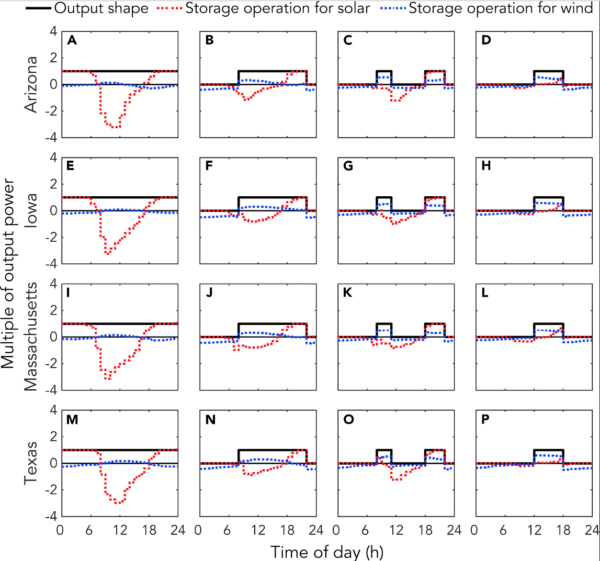A new study, Storage requirements and costs of shaping renewable energy toward grid decarbonization, published last week in the journal Joule by researchers at the Massachusetts Institute of Technology (MIT), finds that technologies with storage capacity costs below US$20/kWh will make them competitive and enable confidence in a 100% renewably supplied electricity system.
This represents a near 90% reduction in current costs of materials and manufacturing of battery-based energy storage systems (BESS), although the researchers say the target varies with the target output profile of different locations.
“It’s a large drop,” said senior author of the paper, Jessika Trancik, an associate professor of energy studies at MIT, in a statement accompanying publication of the paper, “but some technologies do tend to improve a lot as we’ve seen in the case of solar panels.”
Although costs and calculations in the paper relate to the demand and generation profiles of four US locations — Arizona, Iowa, Massachusetts and Texas — and their various energy markets, the broad outcomes and assumptions are of interest across a spectrum of energy jurisdictions.
Explaining the approach of the study, Trancik said, “Quantifying cost targets for energy storage required a new piece of insight about how patterns of the renewable energy supply, and fluctuations in this supply compare to electricity demand profiles.”
The infrequent but sometimes large shortage events in wind and solar generation “are critical in determining how much storage is needed for renewables to reliably meet demand,” says Trancik. This prompted the study authors to consider 20 years of data revealing disparities in demand and potential renewable supply, and the requirement for energy storage.

Graphs: Massachusetts Institute of Technology
What if 5% of demand were met in another way?
The study found another factor could raise the target cost of energy storage to more like $150/kWh: That is, if required supply from wind and solar were reduced by just 5% and met by other sources, this would reduce the cost of required renewable electricity over a 20-year period by around half, allowing for more expensive storage options.
“The trick,” said Trancik, “is to figure out how to supply electricity for the remaining 5% of hours. This could potentially be accomplished with supplemental generation technologies, or perhaps demand-side management. The researchers also conclude that expanding the electricity transmission grid to transport energy and smooth variability between regions will help mitigate renewable energy-supply fluctuations.
Storage, says the paper, offers several advantages over other approaches to addressing the intermittency of renewables. In a statement that will resonate in the Australian context, the authors say storage may require fewer decision makers to agree on transmission expansion, and can be faster and more flexible in its implementation. Storage can also allow for larger quantities of energy to be time shifted when needed than demand-side management, and will likely achieve greater C02 reductions than using back-up generation such as gas turbines.
Where cost targets arrived at in previous studies have been for storage providing energy arbitrage in the electricity system (charging batteries from solar or wind when electricity prices are low for resale when demand and prices are higher), the new study focuses on a future supply system dominated by renewables.
“This work’s novel contribution is to estimate the costs of using wind and solar energy with storage to reliably supply various output profiles,” write the authors.
The solar, wind, battery nexus
Across the states examined, they found that the least-cost energy was generated by a combination of wind and solar — because of their complementary resource availability over time — working in tandem with storage. Researchers point out that while Arizona favoured solar in the mix, Texas leaned into the wind, and the other two states were balanced in their blend of energy resources.
One aspect of the study demonstrated how wind and solar plus storage could be used to provide baseload, intermediate and peak power outputs over a period of 20 years.
It found that, “To provide baseload, intermediate, bipeaker and peaker electricity at $0.10/kWh, with an optimal wind-solar mix, energy storage capacity costs must reach approximately $30–70/kWh, $30–90/kWh, $10–30/kWh, and $10–30/kWh, respectively,” (all values are in US dollars).
What’s in store?
The study also sought to identify the most suitable storage technologies for meeting the general target cost of US$20/kWh. It noted that pumped-hydro energy storage (PHES) and compressed air energy storage (CAES) have low capacity costs, but are limited by available topography offering suitable reservoirs or underground caverns, and their energy density is considerably lower than electrochemical storage.
Electrochemical energy storage systems, on the other hand, have much higher capacity costs, which are exacerbated by degradation over time, and the potential need to replace the storage system, which the paper notes could still make sense if the cost of the technology were extremely low.
“Scenarios in which renewable resources grow to meet a majority of society’s energy needs require finding ways to make a fluctuating renewable energy supply reliably meet demand,” concludes the paper. “Shaping renewables output to match the traditional grid roles of baseload, intermediate, and peaker plants is one possible solution.
“We find that achieving ultra-low storage energy capacity costs is one path for renewables plus storage to cost-competitively fill this role.”
This content is protected by copyright and may not be reused. If you want to cooperate with us and would like to reuse some of our content, please contact: editors@pv-magazine.com.









What people forget to figure in is the value you are taking by building enough wind, solar and transmission to make this happen. Rural citizens are opposing all of this. 230 governments across the US have already banned or blocked industrial wind. People don’t want their land taken for the excess transmission lines required and most people don’t want to pay for what this redundant build out will cost.
“It found that, “To provide baseload, intermediate, bipeaker and peaker electricity at $0.10/kWh, with an optimal wind-solar mix, energy storage capacity costs must reach approximately $30–70/kWh, $30–90/kWh, $10–30/kWh, and $10–30/kWh, respectively,” (all values are in US dollars).”
The study seems to be ‘attached’ to the grid WRT large scale energy generation plants. The residential aggregate grid could also do a decent job of using current and future generation resources in a more efficient manner. When ever one of these studies focuses on utility projects the ‘math’ involved has to also involve the grid’s common failure of centralized generation with power corridors for distribution. Local micro-grids with energy storage would me more efficient IF designed as medium voltage systems without the total step up and step down transformer losses of the current grid business model. When one talks about micro-grids as in a home development community with solar PV and energy storage on every home, the magic USA-ABC power/price point of 350Wh/Kg and $100 per kWh of storage will work just fine.
Excellent studies! It seems clear that solar and wind can together be combined along with energy storage available TODAY at $150/kWh or less to cost-effectively replace 95% of the electrical energy supplies from all baseload, intermediate and peaking generation capacity. The other 5% can readily be met by retaining some turbine peakers, using a renewable, readily stored, net zero-carbon fuel, like cellulose ethanol. With the necessary public commitments and incentives to eliminate greenhouse gas pollution, this can be accomplished by 2030 while at the same time lowering electrical power costs, due to the fast-reducing costs for solar, wind, energy storage, and demand-side management technologies.